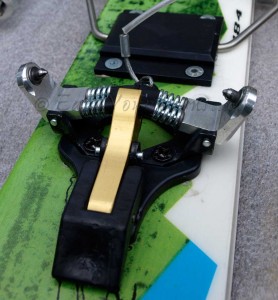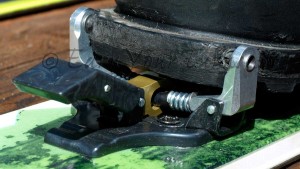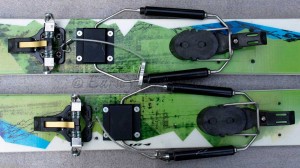By and large the response from mavericks willing to be on the bleeding edge of telemark binding progress has been positive for the Telemark Tech System. Nobody complains about Dynafit caliber touring efficiency. When dealing with the down side, there is lots of spring tension for ripping tele turns in all manner of snow conditions. You have to be willing to invest a little personal time and extra effort to make TTS work since, until this year, you had to piece your binding together based on whatever 2-pin toe you had or could obtain in combination with the OMG cable kit or a DIY cable. To top that off, jigs don’t exist and the number of people you can get first hand accounts from is limited.
TTS = Telemark Touring System
For those who prefer step-in entry, ski brakes and a more reliable safety release, NTN is for you, not TTS. When uphill efficiency is a priority though, it is hard to beat the earn-your-turns functionality of TTS.
Unlike the NTN bindings, you can adjust the cable pivot location for tele-resistance on par with HH #3—#5, but not as conveniently as the Axl or Enzo. Once you dial in what power you like the only shifting you will need to do is between tele and tour mode. The only way you can beat TTS for skinning is by going full rando to shave weight, but then you sacrifice the ability to tele.
Putting it all together is simple enough. The OMG toe keeps the Dynafit 4-hole spacing of the Vertical series, without the fifth hole under the toe lever, so you can use a Dynafit jig for drilling the toe holes. The heel blocks are easy to mount, even without a jig. Although they are not immune to snow building up underfoot, the newer single piece cable block does reduce snow packing underfoot by providing one less cavity for the snow to be trapped by. It will be a great day when a unitary mounting block holds the toe and sheds snow everywhere behind the pins. Until then, a shot of silicone can’t hurt, and I’d also suggest teflon tape over the heel post. Though it is plastic, sticky snow does manage to bond to it which can be the start of a climbing post of snow when you may not want one.
About those turns…

OMG’s toe pins open wide, with a high center, making entry more difficult than average for a 2-pin tech binding.
A key part of the OMG cable system is the heel lever, which has been optimized to latch in securely when placed on top of the heel step, not the heel groove other heel levers are optimized for. With a tech-ready NTN boot, you lose the groove to the Dynafit heel insert.
OMG’s 2-pin tech toe

When closed, the OMG toe does not yield a confident click. Note the shallow angle of the pin arms below the cantilever point.
Further exacerbating that basic lack of a resounding click of the jaws when closed, is getting started when the jaws are open. The center point that swings up for open, or down to close, is much higher than any Dynafit or other brand of 2-pin tech binding out there. This forces an angled style of latching in that puts the boot further away on the high side and harder to align correctly as you rotate your toe down. Of all the 2-pin tech toes I’ve used – Dynafit’s TLT, Vertical, Radical and Beast, G3’s Onyx and Ion, the La Sportiva/ATK, Plum, or Fritschi’s Vipec, — the OMG TTS toe requires the most fiddle to get in, and the most faith to trust. It’s not impossible, but noticeably more challenging. Early on I was getting in about 1-in-5 tries — after half-dozen short tours, that’s down now to one in three. By comparison, I’m typically first try two-out-of-three times with a Dynafit TLT after 30 days. On the otherhand, when you’re opening the binding up to get out, OMG’s high center literally kicks your boot free, unlike the Vipec which, by comparison, has “sticky” pins.
Once you’re in, you’re in solid, but in my testing I locked ’em out anyway — call it a lack of faith. If you compare the position of the arms between the various 2-pin toes when closed, the OMG toe shows the smallest deflection below horizontal, which implies less holding force. Dynafit isn’t a lot more, but it is noticeably more. In fact, were it not for all the new tech toes on the market the ease of entry function wouldn’t merit such scrutiny except that one, G3’s Ion, has clearly set a new standard for stepping in to a 2-pin tech toe — comparisons are inevitable.
The toe lever creates a nice, simple, solid lock and one that, in spite of the relative difficulty getting in to the pins, does hold solid. On the flip side, the toe lock lever has such a solid feel when locked, it takes a bit of force with the tip of your ski pole, strategically placed, to unlock it and open it back up.
Conclusion
While the OMG 2-pin tech toe is a bit more fiddly than other tech bindings, once you figure the tune out, getting in is marginally different than most other tech bindings and familiarity will breed the confidence that inspires faith. In the meantime, Mark Lengel, the man behind TTS, has adjustments in the works to make getting in easier, and snap tight when the pins close without having to lock it down. Others have done it, so it can be done, although, based on results, there appears to be a fair amount of art mixed with science in building a good 2-pin tech toe.
From a functional perspective the TTS complete binding rips great turns and offers the most efficient system for touring of any telemark binding. If you’re willing to be a beta tester, I can confirm, the reward is worth a few risks.
OMG
Telemark Tech System v2014
Complete binding: $400
Weight/pr: 2.0 lbs. (905 g)
Toe Conversion Kit: $350
Heel Conversion Kit: $200
© 2014
Related Posts
Verdict on TTS
Dynafit goes Bisensual
Review of TTS v2.0
BCTalk Thread: TTS strengths, weaknesses, workarounds


5 pings
[…] Review: OMG’s Telemark Tech System – Beta, not Betta’ (April 2014) […]